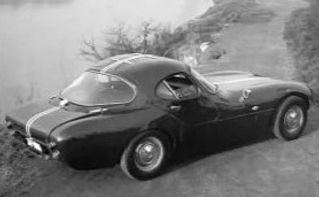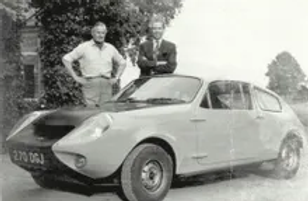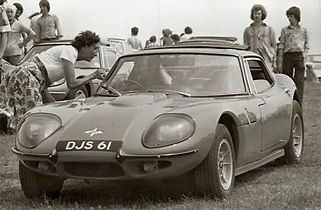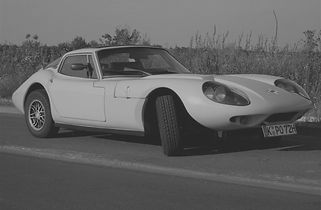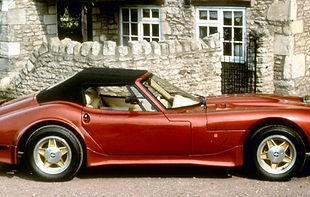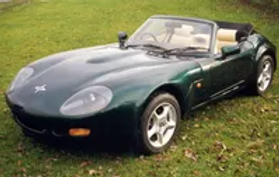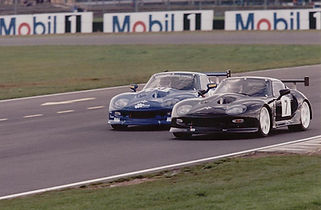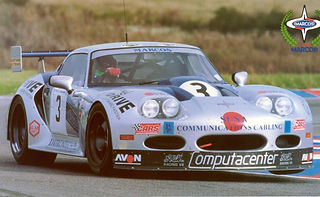

THE HISTORY OF MARCOS CARS
Jem Marsh and Frank Costin, who took the first three letters of their surnames to devise a name for the new company, founded the Marcos marque in 1959. Their first cars drew on Costin’s aviation experience and were remarkable in their use of wood laminates for the monocoque body/chassis unit. Lightweight and good streamlining gave outstanding performance from the relatively modest 1 litre and 1.5 litre Ford engines they used.
As with so many of the smaller British manufacturers spawned during this period, Marcos earned its market pedigree on the racetrack. Notable early customers include Jackie Stewart, who gained his first racing experience in a Marcos, Derek Bell, Jackie Oliver and Jonathan Palmer.
These first cars were no beauties but sold well on sheer capability alone. When Frank Costin left the company in 1961 his creation was placed in the hands of Dennis and Peter Adams. Their first challenge was to simplify the construction technique. During 1963, and intended merely as a stopgap project, the Adams brothers produced designs for the Marcos 1800. Though still relying upon wood for the chassis this new model was clothed in an extraordinarily beautiful fibreglass shell. Indeed this “stopgap” turned out to be so good looking that it was acclaimed an immediate success following its launch at the Motor Show that October and remains the inspiration from the Company’s top models to this day.

Cyril Carpenter preparing a 1500 power unit at Greenland Mills, Bradford-on-Avon
During 1966 the Mini Marcos was introduced; a fibreglass-bodied car utilising trusted Mini mechanicals, including the front wheel drive engine/transmission unit. It sold extremely well, despite being described as “ugly as Hell” by one correspondent. Subsequently the Mini Marcos earned its spurs and reputation on the track, especially at Le Mans in 1966 when it was the only British car to complete the 24-hour race. Over the years the Mini Marcos continued to earn its place in the racing history books, it still holds four National Land Speed Records, has twice won the Mod Sports Championship and its latest accolade to win the 1991 Liege-Rome-Liege rally for Sports Cars beating Porsche, Alfa Romeo, Mini Cooper and Austin Healey.
Throughout this time the Marcos GT remained a solid success but was still hindered by the labour – intensive wooden chassis. In 1969 the Adams brothers were commissioned to design a steel chassis, which appeared in the form of a square section tubular space frame that cut some 15 hours off the manufacturing times of every car. Power units were generally Ford (4 cylinder 1.5 litre and 1650cc, V4 and 3litre V6) and Volvo (the original 1800cc and later the 3 litre straight six). All received excellent reviews from the press, where they compared very favorably with other specialist marques of the time, such as Lotus, Morgan, Gilburn and TVR.

The ill fated Marcos Mantis M70 was introduced to the public at the 1970 Earls Court motor Show, it was received favorably but did not sell in any great numbers, it was the only move by Marcos past or present into a 2 plus 2 grand touring car, acclaimed by some as being too futuristic the car was not a great success, only 32 cars were built between 1970 and 1971.
Also in 1970, encouraged by a healthy order book, the decision was taken to move the manufacturing plant from Bradford on Avon in Wiltshire to a new factory nearby in Westbury. Production volumes were intended to become 6 to 10 cars per week, with a large proportion destined for the United States. Relocation to a new plant interrupted output considerably which, combined with problems involving the main US importer and a widespread collapse in the UK market, resulted in the closure of the original company in 1972.

Chris Marsh, Rory MacMath & Jem Marsh

Marcos Owners Meeting at Westbury on 28th May 1973
Jem Marsh continued in business by establishing a spares and service facility for existing Marcos owners, ably assisted by ex Marcos employee Rory Macmath. In 1976 he re-acquired the Marcos moulds and name, though it was not until 1981 that Marcos GT manufacturing was re-launched. The 1982 Birmingham Motor show saw the rebirth of the Marcos 3 Litre, to be sold predominantly in component form. The decision to offer the car in this form was due to the very buoyant “kit car industry” providing a DIY oriented car with a fine British pedigree. Since then the car has been updated and revised several times, and with various engine options. In 1984 the Mantula Coupe was announced fitted with a 3.5 litre Rover V8, and then in 1986 by the Mantula Spyder. Both versions of the car being updated from time to time the last of these cars using the 200 bhp 3.9 Rover V8 engine up until 1991.
In 1991, to satisfy a growing interest both at home and abroad, the Mini Marcos was re-launched. A number of subtle alterations were made, though the main reservations addressed the concerns of the 90’s through the provision of lead-free engine options and catalytic converters. The 1991 Mini Marcos Mk V was improved to feature wind up windows, 13 in wheels, later door handles and the option of air conditioning and Walnut dashboard. Several of these quite sophisticated little cars were sold to Japan in fully built form, the first non-kit form Mini Marcos` to be sold. Also in 1991 the Martina was introduced to provide a low cost Marcos for the homebuilder. A body and chassis unit similar to the Mantula was produced to take Ford Cortina mechanicals including engine, gearbox, front sub frame and rear axle. To keep the costs as low as possible the body shell was available in a self-coloured gel coat and various modules were available to let the home assembler get stared for a minimal outlay. It was actually possible to build a Martina for less than £10,000 whereas the Mantula started at £18,000.
1993 proved to be a turning point for Marcos. The NEC Motor Show in late 1992 has witnessed the launch of the Mantara. Though visibly related, this latest Marcos was an all-new car that made use of the changes in UK type approval legislation to permit low-volume production and sales through selected dealers. The car was universally acclaimed, and following numerous road tests and reports, has continued to meet with compliments and widespread admiration. Powered by the latest derivative of the famous Rover V8 the Mantara offers outstanding performance, sure-footed road holding and unrivalled practicality.
At the 1993 Motor Show Marcos unveiled the GT Le Mans. Derived from the Mantara but with a completely revised body shell and chassis, this is the Marcos that brings the famous name back onto the racing circuits of the world. With a top speed of over 200 mph, this is the company’s contender from the new GT class in the BRDC GT Challenge and, ultimately, the Le Mans 24 Hours. Under the Team Marcos-Computacenter banner the 1994-racing program proved hugely successful with the LM500 racecars competing in the UK BRDC GT Championship, returning in 1995 with the brand new LM600. Where the LM500 was impressive the LM600 was astounding. It took pole position first time out, achieved a GT2 class victory in its next race and then outright victory as an encore against all classes. The LM600 went on to dominate and finally win the 1995 BRDC National Sports GT Championship. In June 1995 the team went to France for the famous Le Mans 24 hour race, finishing the grueling event seventh in class quite an achievement for a small manufacturer.
1997 and we see the next evolution of the LM series in the shape of the Mantis, not to be confused with the four seater car of the seventies. The 4.6 quad cam Ford V8 engine developing a full 325 bhp giving the car an acceleration time 0-60 in around 4 seconds powered the new Mantis. The body styling was changed to an all-new aggressive look with huge wheel arches and a massive power bulge to house the new Ford engine. Sales looked good. With the Mantis established and selling well in 1998, the Mantis Challenge was launched, this was a one make racing series that was designed to be an affordable way into GT racing, all the cars were built to the same specification and used a 395 bhp engine. The Challenge was run by the BRDC and turned out to be extremely popular and an excellent publicity engine, gaining the company valuable television coverage.
To compliment the Mantis in 1999 the much smoother and less aggressive Mantaray was introduced, this was an all-new styling package mounted on virtually the same chassis as the Mantis but using the well-proved Rover V8 engine of previous models. This time the engine options included the 230 bhp 4.0 litre or the 290 or 340 bhp 4.6 litre. The main body changes were to the totally new bonnet and a conventional style boot and luggage area. A very user-friendly car, only 18 of these pretty cars were made.
The last car to be produced was the outrageous Mantis GT this was powered by the same 4.6 quad cam Ford engine but boosted to an amazing 500+ bhp by the addition of a supercharger and charge cooling, the resulting power is awesome. The other features on this model are 3in drain pipes purporting to be exhausts, the random use of carbon fibre, huge racing brakes, racing rear wing, magnesium racing wheels, roll hoop and all the luxuries you would expect at a massive £55,000. Less than 10 GT cars were built before the final chapter of the Great British Sports Car.
The final chapter being the appointment of the receiver in early 2001, but this is not the end, merely a breathing space. Marcos Heritage secured the future by buying all the assets, which include the moulds, tooling and jigs going back in some cases to 1960. We have all the original drawings and individual car build files to enable us to reproduce parts to the correct specification and supply any information on any particular car. The Heritage team (all ex Marcos employees) are able to carry out all forms of repairs, upgrades, servicing, restoration, insurance work and paintwork on any Marcos 1959 to date.
Rory MacMath
THE MARCOS MODEL RANGE
Xylon - The Ugly Duckling

The word Xylon comes from the Greek for wood. Manufactured from 1959 to 1960 this was the first of the Marcos models. Powered by the Ford 105E engine, the cars were originally built in Dolgellau in Wales, and then later in Luton. Of the 9 cars built, most were competition cars, and were driven with great success by the likes of Sir Jackie Stewart and Jackie Oliver.
Marcos 1800

Unveiled at the 1964 Earls Court Racing Car Show, the 1800 Volvo powered Marcos GT stole the show. This was a totally new car and a shape way ahead of its time, designed by the Adams brothers. Produced from 1964 to 1966, there were approximately 100 cars built at Greenland Mills, Bradford On Avon.
Marcos 1600

The 1600 followed the 1500/1650 with the introduction of Ford's new 1600 crossflow engine. The car was virtually identical to the 1500 / 1650, with a few minor alterations. Of all the early series cars, this proved to be one of the most popular with around 200 cars being built at Greenland Mills, Bradford on Avon between 1967 and 1969.
Marcos 1600 - Metal Chassis

From 1971 to 1972, an economy version of the 1600 with a metal chassis was produced, utilising the Ford MK2 1600 cross flow engine and gearbox. The car had no bumpers, sills or head lamp covers. It was built to a somewhat basic specification. Only 6 cars were produced.
Marcos ceased production and went into receivership in 1972. No cars were produced between 1972 and 1981.
2nd Generation Cars

The 3 litre shape was reintroduced in 1981 in component form to the following engine options: 3 Litre Essex V6, 2.8 Cologne V6, 1600 Crossflow, 2 Litre / 2.5 Triumph straight six, 2 Litre Ford Pinto and the 2.0 Ford V4. Around 130 of these self build cars were produced from 1982 through until 1989/90.
Martina

In 1991 the Martina was launched. It was based on the Mantula shape as a budget version of the model. Nearly all Martina's were component cars utilising the engine, transmission and suspension from the Ford Cortina MK 4 & 5. Both Spyders and Coupes were produced and engines varied from 1600 Pinto to Cologne V6. Approximately 80 cars were built through till 1994.
Mantara

Based on the Mantula V8 injection, the Mantara was launched in 1992. It featured a re-vamped body and an updated interior. The main feature of the car being the front suspension that was modified to use the McPherson strut. All cars from this time onwards were factory built. The Mantara also had the option of fitting the 2.0 and 2.0 Turbo Tomcat engine. 137 Mantaras in all were produced at the factory in Westbury from 1992 to 1998.
Mantis

In 1997, the Mantis was launched. It was a successor to the LM range of cars, and the most powerful road going Marcos ever produced. Powered by the 4.6 Ford Mustang engine and drive train, the Mantis GT version was available producing 500 bhp in supercharged intercooled form. 51 cars in all were produced from 1997, the last being built in 2002 by Marcos Heritage.
LM 400 & 500

The LM 500 road cars were introduced in 1994 to compliment the success of Marcos in the British GT Championships in 1994/95 and competing at Le Mans in 1995. Powered by the 4.0 (LM 400) and 5.0 (LM 500) Rover V8 engines, 35 LM's in total were built from 1995 to 1998 including one LM 200 that was bound for Greece.
In 2000 Marcos Sales Ltd was put into administration and the assets of the company were acquired by Marcos Heritage. In 2002 Californian Tony Stelliga bought the Mantaray II project and developed the range of TS cars Marcos Engineering Ltd.
TS250 & TS500
The TS 250 (Marcasite) was launched in 2002. Based on the Mantaray, it utilised the same Marcos steel chassis and McPherson struts as per the earlier Mantara, LM and Mantis models, but was developed with the Ford Duratech 2.5 V6 engine. Only 7 of these cars were made. In 2003 the TS 500 came along with a restyled bonnet and was fitted with a 5 Litre Rover derived V8 Javelin engine. Less than a handful of these cars were made.
In 2004 Marcos Engineering Ltd moved out of Wiltshire and into new premises at Kenilworth, the TS 500 was phased out and the revamped TSO range appeared.
TSO Range

The TSO range incorporated a 5.7 Cheverolet engine into the restyled Marcos. The styling broke away from the traditional Marcos profile incorporating many new features bringing Marcos into the 21st Century. Shortly after the TSO came along, the GT, GT2, GTC and RT versions were launched spanning from 2004 to 2007. Less than 12 cars in all were made.
In Oct 2007 - Marcos Engineering Ltd went into administration.

